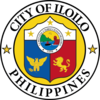| Plaza Libertad | |
|---|---|
| Plaza Alfonso XII | |
 Plaza Libertad with San Jose Church in the background | |
 | |
| Type | Urban park, town square |
| Location | Iloilo City, Philippines |
| Coordinates | 10°41′33.4716″N122°34′25.2228″E / 10.692631000°N 122.573673000°E |
| Area | 1.28 hectares (3.2 acres) |
| Created | 1800s |
| Etymology | Alfonso XII |
Plaza Libertad, formerly known as Plaza Alfonso XII, is a historic plaza or town square in Iloilo City, Philippines. It is considered the site where the flag of the first Philippine Republic was raised in triumph after Spain surrendered Iloilo, the last Spanish capital in Asia and the Pacific, to the revolutionary forces led by Gen. Martin Delgado on December 25, 1898. [1]
Contents
Plaza Libertad is located in front of Iloilo City Hall in Iloilo City Proper and is one of the six district plazas in Iloilo City.



